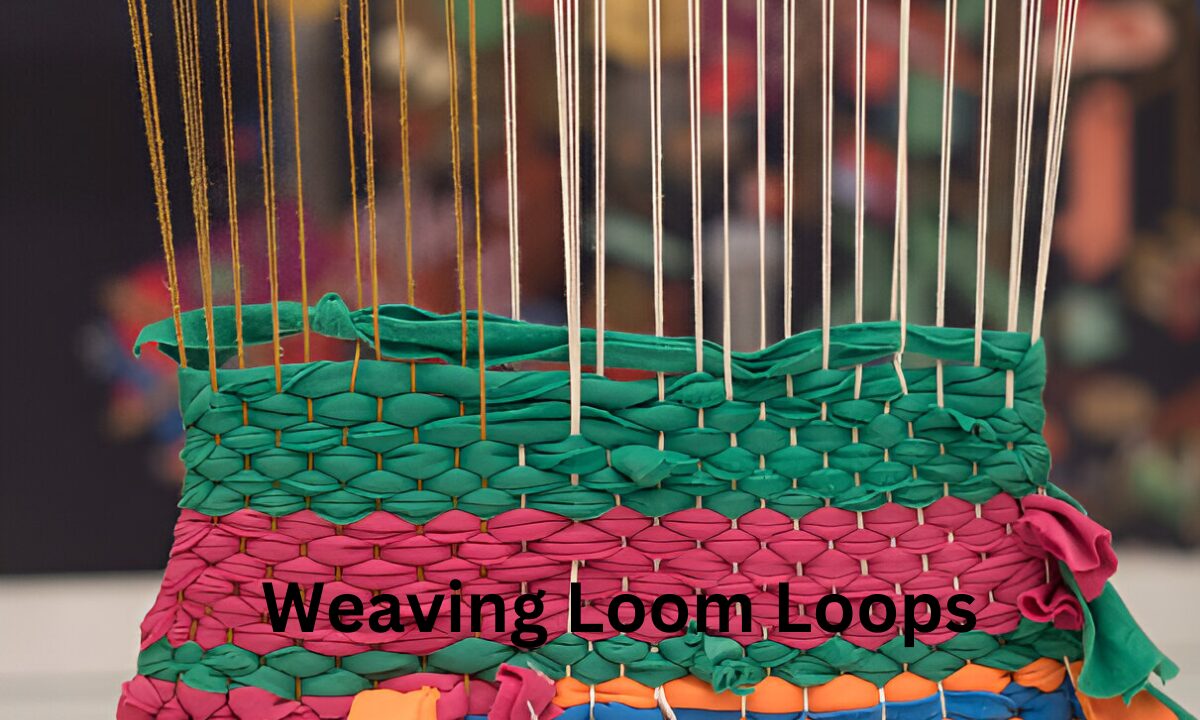Weaving has been an essential craft for centuries, and with the rise of various tools, the weaving loom has become a staple for anyone passionate about creating fabric-based art. Among the tools, weaving loom loops are particularly popular because they allow for intricate patterns and designs. In this guide, we’ll dive deep into weaving loom loops, their uses, types, and how to incorporate them into your weaving projects.
What Are Weaving Loom Loops?
Weaving loom loops are small, stretchy bands used in conjunction with a weaving loom to create woven items like bracelets, keychains, and even small blankets. They are typically made from rubber or fabric and come in various colors, providing endless design possibilities.
The looped bands are threaded onto the loom’s pegs, and as you weave, the loops are pulled, arranged, and tightened to form a complete woven item.
Why Are Weaving Loom Loops Important?
Weaving loom loops are integral to the weaving process for several reasons:
- Flexibility: The loops stretch and adjust, allowing for intricate and varied patterns.
- Color Variety: Available in multiple colors, they enable vibrant, eye-catching designs.
- Ease of Use: These loops are beginner-friendly, allowing crafters to create professional-looking woven items quickly.
- Durability: Once woven, the loops create a sturdy structure, making the finished items durable.
Types of Weaving Loom Loops
Weaving loom loops come in various types depending on their material, size, and purpose. Understanding these types will help you select the right loops for your project.
1. Rubber Weaving Loom Loops
Rubber loops are the most common type used in weaving. They are made of durable rubber, which makes them stretchy and ideal for creating tight, secure weaves. Rubber weaving loops are typically used for making jewelry, like bracelets and necklaces.
2. Fabric Weaving Loom Loops
Fabric loops are made from soft, cotton or nylon material. These loops are usually more vibrant and less stretchy than rubber loops but are more suited for projects that require a softer texture, such as scarves or blankets.
3. Silicone Weaving Loom Loops
Silicone loops are similar to rubber loops but tend to have a softer and more flexible texture. These loops are great for creating items that need to be both stretchy and resilient, like stretchable headbands or pet accessories.
4. Eco-Friendly Weaving Loom Loops
Eco-friendly loops are made from biodegradable materials, offering a sustainable alternative to traditional rubber or silicone. These loops are ideal for environmentally conscious crafters who want to make beautiful woven projects without impacting the planet.
5. Glitter and Specialty Weaving Loom Loops
For projects that need a little sparkle or shine, glitter or specialty loops are the perfect choice. These loops are infused with glitter or other materials like metallic threads, giving your woven items a unique finish.
Choosing the Right Loom Loop for Your Project
When selecting the right loom loop for your weaving project, you should consider the following factors:
| Factor | Rubber Loops | Fabric Loops | Silicone Loops | Eco-Friendly Loops | Glitter Loops |
| Stretchability | High | Medium | High | Medium | Medium |
| Durability | Very Durable | Less Durable | Very Durable | Durable | Less Durable |
| Best For | Jewelry, Accessories | Blankets, Scarves | Headbands, Pet Items | Sustainable Crafts | Decorative Items |
| Texture | Firm | Soft | Smooth | Natural | Textured |
| Eco-Friendly | No | No | Yes | Yes | No |
How to Use Weaving Loom Loops: A Step-by-Step Guide
Using weaving loom loops is a simple process, but mastering the technique can take some practice. Here’s a basic step-by-step guide to help you get started:
Step 1: Set Up Your Loom
To begin, set up your weaving loom according to the manufacturer’s instructions. Most looms come with a set of pegs that you’ll use to place the loops. Some looms are designed to create specific patterns, so make sure you’re using the right loom for your desired outcome.
Step 2: Choose Your Loom Loops
Select the loops for your project. This might involve picking a color palette or choosing specific types of loops based on your design. Make sure you have enough loops to complete your project.
Step 3: Start Looping
Place the first loop on the loom peg, then stretch it across to the adjacent peg. Continue adding loops in a consistent pattern, ensuring they are evenly spaced. For a traditional loom, you’ll want to loop the bands in a figure-eight or similar pattern.
Step 4: Weave the Loops
To begin weaving, use a hook or weaving tool to pull the loops over each other in a pattern. Depending on your project, you may need to alternate colors, stretch the loops to fit or adjust the tension as you go.
Step 5: Secure the Weave
Once you’ve completed the weaving, carefully remove the woven loops from the loom and secure the edges to ensure they don’t unravel. You can use a finishing knot or sewing technique to keep everything in place.
Step 6: Final Touches
Add any final touches, such as tying knots, adding clasps to a bracelet, or trimming the excess loops. Your project should now be ready to enjoy!
Common Projects Using Weaving Loom Loops
Weaving loom loops are incredibly versatile, and there are countless projects you can create with them. Some of the most popular include:
1. Loom Bracelets
Bracelets made with weaving loom loops are one of the most common projects. These can range from simple designs to intricate patterns, often incorporating several colors and varying loop types.
2. Keychains
Loom loops can be used to create fun, customizable keychains that reflect your style. This is a perfect project for beginners, as it’s small and can be completed quickly.
3. Home Décor
For those who want to take weaving to the next level, loom loops can be used to create beautiful home décor items, such as woven wall hangings, placemats, and even pillow covers.
4. Scarves and Blankets
Larger looms and fabric loops can be used to weave items like scarves, blankets, or table runners. These projects take more time, but the results are both functional and stylish.
5. Hair Accessories
Using silicone or fabric-weaving loom loops, you can create headbands, hair ties, or decorative clips that are stretchy and comfortable to wear.
Advanced Weaving Loom Loop Techniques
Once you’re comfortable with the basics, you can try more advanced techniques to add complexity and uniqueness to your projects.
1. Adding Beads or Charms
To give your woven creations an extra flair, try adding beads or charms to the loops before weaving them. This technique is perfect for making customized jewelry or decorative keychains.
2. Color Blocking
Color blocking involves using distinct blocks of colors within your weave. This is a great way to create bold patterns or even incorporate your favorite color combinations into the design.
3. Creating 3D Effects
For those interested in a more textured design, 3D effects can be created by adding extra loops or even weaving at different tensions. This results in a raised, dimensional effect that adds depth to the design.
4. Experimenting with Different Loop Types
Try mixing different types of loops (e.g., rubber with fabric or glitter with eco-friendly) to create contrast within your woven items. This can help bring even more life to your projects.
Maintaining Your Weaving Loom Loops
To keep your loops in good condition and ensure they last for many projects, it’s important to maintain them properly.
Storage Tips
- Store loops in a cool, dry place to prevent them from losing elasticity.
- Use containers to separate different colors and types of loops, making them easy to access when needed.
Cleaning Your Loops
- If the loops get dirty, you can gently wash them in warm soapy water and air dry them.
- Avoid using harsh chemicals or high heat, as this can damage the material.
Conclusion: Let Your Creativity Flow with Weaving Loom Loops
Weaving loom loops are a fantastic way to unleash your creativity and produce beautiful, functional, and decorative items. Whether you’re making bracelets, home décor, or accessories, the possibilities are endless. By choosing the right loops and learning new techniques, you can elevate your weaving game and create masterpieces that will impress everyone.
Frequently Asked Questions (FAQs) About Weaving Loom Loops
1. What are weaving loom loops made of?
Weaving loom loops are typically made from materials like rubber, silicone, fabric, or eco-friendly materials. Rubber and silicone loops are common because they are stretchy and durable, while fabric loops offer a softer, more flexible texture. Eco-friendly options are made from biodegradable materials for those looking for sustainable crafting alternatives.
2. How do I choose the right weaving loom loops for my project?
The choice of weaving loom loops depends on the project you’re working on. If you’re making bracelets or keychains, rubber or silicone loops are ideal due to their durability and stretchability. For softer items like scarves or blankets, fabric loops work best. If you’re concerned about sustainability, eco-friendly loops are a great choice. You can also use glitter loops for decorative projects that need some sparkle.
3. Can I use weaving loom loops for large projects like blankets or wall hangings?
Yes! Larger fabric loops are perfect for bigger projects like blankets and wall hangings. For such projects, you might also need a larger loom to accommodate the greater number of loops and more intricate patterns. These larger weavings often take more time to complete but are ideal for crafting functional and beautiful pieces for your home.
4. Are there any tips for making my weaving loom loop projects more durable?
To ensure your woven items are durable, here are a few tips:
- Use high-quality loops made from sturdy materials like silicone or rubber.
- Secure the ends of your project by tying off the loops tightly or using a finishing knot to prevent the weave from unraveling.
- Avoid overstretching the loops, as this can weaken their elasticity and cause them to snap.
- For projects like bracelets, consider adding beads or other embellishments to reinforce the design.
5. How do I store my weaving loom loops?
To maintain the elasticity and quality of your weaving loom loops, store them in a cool, dry place away from direct sunlight or heat sources. Keep them in airtight containers or separate bags by color and material to avoid tangling. Avoid storing loops in damp conditions, as moisture can degrade the material over time.
6. Can I mix different types of weaving loom loops in one project?
Yes! Mixing different types of loops can create unique and visually interesting designs. For instance, you can combine rubber loops for durability with fabric loops for a softer texture. You can also experiment with glitter loops or eco-friendly loops to add special effects to your woven items. Just be mindful of the loop sizes and elasticity, as mixing too many materials might affect the overall tension and stability of the weave.
7. What size weaving loom loops do I need for different projects?
The size of the loop you need depends on the loom you’re using and the scale of your project. For bracelets and small accessories, standard-sized rubber or silicone loops work well. For larger projects like scarves, blankets, or home décor, you may want to use larger fabric loops. Be sure to choose loops that match the peg spacing and tension requirements of your loom.
8. Can I use weaving loom loops for projects other than weaving?
Absolutely! Weaving loom loops are versatile and can be used in various other crafting projects such as:
- Keychains: Combine colorful loops for unique, personalized keychains.
- Hair Accessories: Make hair ties, headbands, or clips using silicone or fabric loops.
- Jewelry: Weave colorful loops to create bracelets, necklaces, or earrings.
- Decorative Pieces: Create colorful, textured art pieces or wall hangings.
9. Can weaving loom loops be washed?
Yes, weaving loom loops can typically be washed. For rubber or silicone loops, wash them with warm, soapy water and air dry. Fabric loops can also be hand-washed or machine-washed on a gentle cycle, depending on their material. However, avoid using high heat or harsh chemicals to clean the loops, as this may cause damage or discoloration.
10. Where can I buy weaving loom loops?
You can find weaving loom loops in many craft stores, both in-store and online. Websites like Amazon, Etsy, and specialty craft retailers offer a wide variety of weaving loom loops in different colors, materials, and sizes. Make sure to choose a reputable supplier to ensure you’re getting high-quality loops for your projects.



